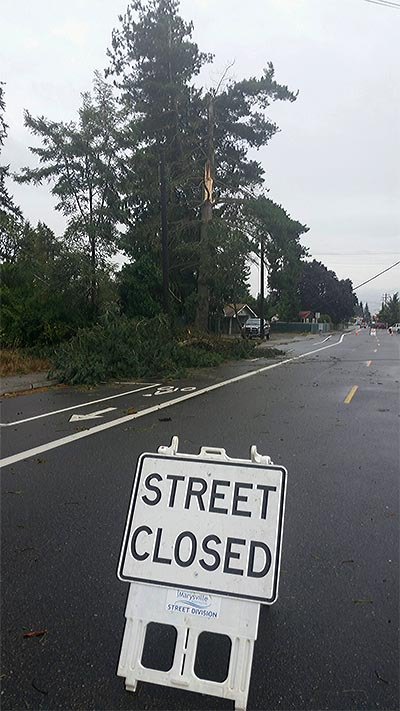When 175,000 residents of Snohomish County lost power Aug. 29, PUD spokesman Neil Neroutsos noted it was the highest number since 1993.
“It was all over the county,” Neroutsos said. “Transmission lines were down south as far as Edmonds and Mountlake Terrace, and east to Clearview.”
By Aug. 30, Neroutsos reported the PUD had restored power to 100,000 county residents, and kept about 50 crews out in the field that Sunday.
“Our service crews are typically two-person crews that identify problems and perform quick repairs,” Neroutsos said. “Our line crews average about six people each, and are followed by our tree-trimming crews, whose numbers can vary.”
Aug. 31 saw the PUD joined by mutual aid crews from the counties of Grant, Cowlitz, Chelan and Benton, although he acknowledged that the continuing wildfires on the eastern side of the state are taxing some of those resources.
As it stands, the first wave of PUD crews worked 40 hours, from the afternoon on Aug. 29 to the morning of Aug. 31, before going on break and being relieved by fresh workers.
“We have crews who weren’t working over the weekend who we’re cycling in,” Neroutsos said. “We’re pretty well-prepared for these types of storms, with the ability to get crews out quickly. Already on Friday, we were tracking forecasts of potentially heavy wind, and we knew the trees were brittle.”
Although PUD workers routinely trim trees along hundreds of miles of power lines, this storm proved more powerful because it came so early. Most such windstorms arrive in the fall, after trees have started shedding their leaves. But the leaves on the late August trees caught the wind enough to topple far more branches, and even trees themselves.
“You can never have a crystal ball,” Neroutsos said. “Because of the convergence zone, we didn’t know if the storm would break north or south. All you can do is have your crews and supplies ready to go.”
One concern expressed by many residents was the lack of an online map indicating which areas were without power.
“We’re in the first phase of collecting better data over the next six months,” Neroutsos said. “After that, we hope to offer a site that people can check on their smart phones.
He added: “We understand that knowing whether the power is on at their homes allows folks to decide whether they want to go shopping or hang out with friends first, and see if they can wait it out until the power comes back on.”
In the meantime, Neroutsos admitted that residents of remote and heavily wooded areas will often take longer for crews to reach, so they should be prepared with emergency kits and backup generators.
Kevin Nielsen, public works director for the city of Marysville, said none of his customers experienced outages of water or sewer services, thanks to the city’s reliance on backup generators.
“Over the years, as we’ve had more and more of these windstorms, we’ve added more and more generators, and equipped them with auto-transfer switches,” Nielsen said. “That way, as soon as the power grid went out, our sewer stations and wastewater treatment plant got their power back.”
Nielsen reported that city streets and utility crews worked throughout the weekend, since Marysville’s service area extends beyond its city limits.
“Almost all of our customers lost power at one point or another,” Nielsen sad. “Marysville proper got its power back around three in the morning on Sunday, while other areas went 19 hours or longer. Some might not have had their power restored until this morning,” he said on Aug. 31.
As prepared as Marysville was, Nielsen sees room for improvement. He wants to improve the monitoring system for the city’s drinking water during such power outages, as well as arm its traffic signals with backup batteries.
Like Neroutsos, Nielsen noted the added impact of having such strong winds hit when trees still had their leaves, which affects Marysville’s utilities in another way.
“Usually it’s the fall before we have to remind our residents to clear the leaves out of their catch-basins, to prevent storm water from flooding our streets,” Nielsen said.



